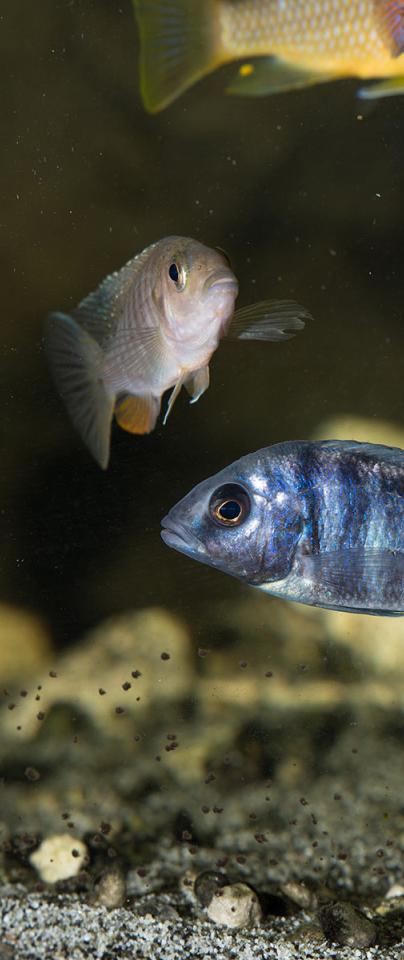The genetic machinery that drives biodiversity
Thanks to new technologies and novel approaches to big data, researchers are revealing new secrets into the genetic processes that power Cichlid evolution.
Cichlids come in all shapes, sizes and colours. These fish can also live very different lives, showcasing a wildly diverse range of behaviours, diets, and adaptations to their habitat. Yet the genomes of different species are almost identical.
Thanks to the advent of new technologies, and by developing novel approaches to process ‘big data’, researchers at the Earlham Institute are revealing new secrets into the genetic processes that power evolution.
If evolution ever needed a poster child, the cichlids would be hard to beat. In the same two or three million years it took for 14 species of finch to evolve on the Galapagos Islands, around 1,000 species of cichlid diverged in Lake Malawi alone.
East African cichlid fish are prime examples of adaptive radiations, where a species quickly diversifies and each new lineage has a particular set of traits that help it occupy a different ecological niche.
Some cichlids adapted to the rivers while their relatives stuck to the great lakes of East Africa, the eyes of some were better suited to hunting prey in the depths, and there were those that could tolerate more brackish waters. The rapid emergence of new species and adaptations has made these fish an iconic organism for evolutionary biology.

Historically, you might sequence the genomes of different species and then compare them, hoping to spot obvious similarities and differences. These variations can then start to be linked to the physical differences between the animals, helping to provide markers for adaptive traits.
In the case of cichlids, things aren’t that simple.
“The genomes of different cichlid species might be close to 99.9% identical, yet they can look totally unrelated,” explains Dr Tarang Mehta, Postdoctoral Research Scientist in the Haerty Group at the Earlham Institute.
“These similarities in genome sequence imply that a number of genetic factors - beyond the simple presence and absence of coding regions - could be responsible for the amazing diversity of traits we observe.”
Mehta’s latest research, published in Molecular Biology and Evolution, reveals new insights into the explosion of cichlid biodiversity and, crucially, approaches to identify phenotypic markers - the specific sequences of DNA that work in concert to define the observable traits.
“The development of an animal’s body plan is controlled by large gene regulatory networks, or GRNs, a network of complex interactions between genes and regulatory factors that control how and when those genes are expressed,” explains Mehta.
Each of the components in the network can evolve at different rates and ways in each species. This, coupled with the cichlids’ ample opportunity to explore a wide range of environments, appears to be a major contributor to the emergence of phenotypic diversity and rapid adaptation.
“Cichlid adaptive radiations are off the charts,” says Mehta. “To understand how a particular phenotype has evolved, you need to map out the GRN that defines it.
“These networks can be incredibly complex, with hundreds and potentially thousands of combinations of activator and repressor interactions of a single gene’s expression level in a particular tissue.”


“This work is also being adapted in other species and strains to better understand adaptation to particular environments.”

Once a GRN is defined in one species, the next challenge is to compare these interactions between the same tissues of multiple related species.
Mehta, along with colleagues and collaborators at UEA and the University of Wisconsin–Madison, wanted to simplify the comparisons of these interactions in order to learn more about the origins of cichlid diversity.
The team focused on five species, including two river-dwelling species and a representative from each of the three great lakes of East Africa.
“We scanned the genomes for specific signatures that regulatory factors use to bind and control a gene’s expression level,” explains co-author and Earlham Institute Group Leader Wilfried Haerty.
“The binding site’s associated regulator could then be mapped to a gene - based on being identified in an associated regulatory region of that gene - to help us build a network of interactions.”
Using this approach, they were able to define the co-regulation of target genes (TGs) in networks by proteins controlling gene transcription - transcription factors (TFs). This was combined with data on non-coding RNAs (miRNAs) that mostly post-transcriptionally repress gene expression.

The genomes of different cichlid species might be close to 99.9% identical, yet they can look totally unrelated, these similarities in genome sequence imply that a number of genetic factors - beyond the simple presence and absence of coding regions - could be responsible for the amazing diversity of traits we observe.

Owing to the nature of these co-regulatory interactions, and to simplify their comparisons between species, the interactions were separated into nearly 18 million TF-TG-miRNA interactions, referred to as ‘three-node motifs’.
Armed with this extensive set of three-node motifs, the authors then studied how these were gained and lost along the phylogeny due to genetic variation at regulatory binding sites.
“We found thousands of cases of rewired regulatory interactions, or motifs,” says Mehta. “These appear to have evolved rapidly in genes associated with traits of cichlid phenotypic diversity.”
The most rapidly rewired three-node motifs and GRNs were in opsin genes, which are associated with visual systems. The changes in opsin gene regulation and expression are likely responsible for the fine-tuning of cichlid vision in response to prey, ambient light changes, or even social signals.
When the authors looked deeper into the phylogeny of Lake Malawi cichlids, they noticed that small changes in binding sites of TFs and miRNAs in regulatory regions of particular opsin genes - such as SWS1, a gene that helps with sensitivity to UV light - were common to particular clades of the phylogeny with similar habits and ecosystems.
The differential regulation of opsin genes in three-node motifs between cichlid species and their implications towards visual tuning could therefore correspond to diversity of foraging habits, diet, habitat choice and even nuptial colouration.
“The tinkering of regulatory networks appears to be widespread even between closely related cichlids,” says Mehta. “As we add more ‘omics’ data from the different radiations, we’ll be able to further define the regulatory plasticity that can explain how cichlids have adapted to their different environments.”

One of the species studied in this research was the Nile tilapia, a fish used widely in aquaculture. The Nile tilapia is becoming an increasingly valuable source of food, which means aquaculture breeders desperately want access to genomic resources that can inform their programmes.
The approaches developed in this research will support efforts to identify markers for specific traits breeders want to select for.
“For example, we want to find markers for higher tolerance to saline waters, resistance to infection, and other obvious traits relevant to farming fish, such as size and growth rate,” explains Haerty.
“This work is also being adapted in other species and strains to better understand adaptation to particular environments.”
With climate change, sustainability and food security in the front of breeders’ minds, the ability to quickly and cheaply select for beneficial traits will be transformative.
The research is the latest in a number of publications from this Group that are gradually improving our understanding of how, where, and at what rate evolution takes place in the genome.
“The next step will be to integrate epigenetics, which will give us more tissue-specific regulatory information,” says Mehta. But he believes the approach won’t be limited to evolutionary biology.
“As the regulatory hallmarks are characterised in other systems, there’s no reason why we couldn’t adapt the approach to tackle other systems, or even human diseases, such as cancer, congenital heart defects and neuromuscular disorders.”
It seems a bit of rewiring and adaptation of their methodology may be the next step in the evolution of this research.
Evolution of miRNA binding sites and regulatory networks in cichlids is published in Molecular Biology and Evolution on 24 June 2022. Authors: Tarang K Mehta, Luca Penso-Dolfin, Will Nash, Sushmita Roy, Federica Di-Palma, Wilfried Haerty.